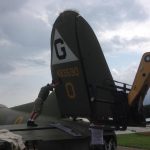
Last week, WarbirdsNews visited the Museum of Aviation at Robins AFB in Warner Robins, Georgia and we had the opportunity to talk with museum curator Mike Rowland and Bob Denison, the B-17 Project Manager. As many of our readers will know, the National Museum of the US Air Force transferred B-17G 44-83690 to the Museum of Aviation some months ago. The aircraft had been on outdoor display at the Grissom Air Museum in Peru, Indiana for more than half a century, and had no prospect of finding a home inside at that museum any time soon. With the B-17′s long-term future in mind, it became clear that the aircraft had to find a new home somewhere else where she could go on display indoors. The Museum of Aviation had set aside hangar space for just such a prize following the disposal of several surplus exhibits last year, so it made sense for the Fortress to come to Warner Robins, especially as the facility is one of the finest within the US Air Force Museum System.
This article will be WarbirdsNews’ first concerning the B-17’s restoration, and we plan on frequent updates as the work progresses. As you would expect, the museum had first to prioritize planning for the aircraft’s arrival, so not a lot of actual restoration work has taken place just yet. However, museum staff stated, “After we got the fuselage into the Scott Hangar, one of the first tasks to be completed was removing all the windows. That was a quick and satisfying job. Floorboards and the top and chin turrets were also removed. A top priority now is building fixtures for the front and rear fuselage so we can split the fuselage at the production break behind the radio room. The two fuselage sections will be much easier to access and move around. Once the fuselage is split, we’ll get the paint stripped inside and out and then make a careful assessment of the condition. Our restoration team has made good progress on identifying and tagging loose parts. They’ve also been opening access panels on both the fuselage and wings for inspection purposes. One engine support fixture has been completed and the engine installed for both display and future restoration work. A second engine fixture is in progress.”
Even if visible restoration progress may be slight just at the moment, it is a major step forwards to have this Flying Fortress in from the cold once more, and to have the certain promise of abundant care lavished upon her in the near future. WarbirdsNews looks forward to reporting further on this project in the near future!
For those wishing to contribute to the B-17′s restoration, please do click on the Museum’s donation page HERE.
[inpost_galleria thumb_width=”200″ thumb_height=”200″ post_id=”22441″ thumb_margin_left=”3″ thumb_margin_bottom=”0″ thumb_border_radius=”2″ thumb_shadow=”0 1px 4px rgba(0, 0, 0, 0.2)” id=”” random=”0″ group=”0″ border=”” show_in_popup=”0″ album_cover=”” album_cover_width=”200″ album_cover_height=”200″ popup_width=”800″ popup_max_height=”600″ popup_title=”Gallery” type=”yoxview” sc_id=”sc1447695163682″]



























